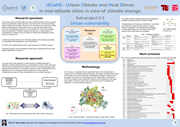Research Module 3.2 Urban Vulnerability
General
The objectives of this module are (1) a multi- scale analysis of vulnerability of the population to urban heat stress, (2) a risk analysis to indoor and outdoor urban heat stress for selected vulnerable population groups, (3) scenario development of likely future vulnerability and risk under different alternatives of options. To account for the heterogeneous and multi- dimensional datasets and to explore conditional dependencies between influencing variables we focus on a machine-learning modelling approach for urban heat stress. The expected outcomes are methodological developments of machine-learning for modelling vulnerability and risk and insights on urban heat stress for further developing coping strategies.
Research questions
- What are the dimensions of vulnerability to heat stress and how are they interlinked to each other?
- What are the dimensions of heat-stress risk for selected vulnerable groups and how are they interlinked to each other?
- What are present spatial patterns and underlying processes of vulnerability and risk to urban heat stress in an urban area? And what are likely future patterns and processes under different alternatives?
- How far can a machine-learning approach be used to model vulnerability and risk to urban heat stress in a multi-scale and multidimensional way?
Collaboration within Research Links (RL)
| 410b | Linkages between indoor heat-stress hazard and vulnerability |
| 470 | Political and social influences on vulnerability to heat stress |
| 480 | Specific vulnerable groups |
Collaboration within Research Cluster (RC)
| 520 | Present-day heat-stress hazards, vulnerabilities and risks |
| 530 | Effectiveness of actions for reducing heat-stress risks |
